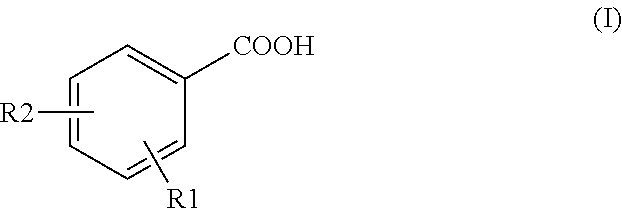Method for detecting tracer compounds for hydrocarbon production
a tracer compound and hydrocarbon technology, applied in the field of detecting tracer compounds for hydrocarbon production, can solve the problems of cumbersome method implementation and time-consuming analysis (about 60 minutes)
- Summary
- Abstract
- Description
- Claims
- Application Information
AI Technical Summary
Benefits of technology
Problems solved by technology
Method used
Image
Examples
example 1
Analysis without Sample Preparation
[0084]Detection assays were conducted for 2-fluoro-5-(trifluoromethyl)benzoic acid (2F-5tFmBA), 5-chloro-2-fluorobenzoic acid (5Cl-2FBA) and also 4-fluorobenzoic acid (4FBA), 2,4-difluorobenzoic acid (2,4dFBA), 3,4,5-trifluorobenzoic acid (3,4,5tFBA), 4-trifluoromethylbenzoic acid (4tFmBA), 2,3,4,5-tetrafluorobenzoic acid (2,3,4,5tetraFBA) and 3,5-bis(trifluoromethyl)benzoic acid (2,5bistFmBA) using UPLC / MS / MS, without any preparation of the samples (except for filtering through 0.2 nm filter). The compounds were dissolved in water derived from a hydrocarbon deposit.
[0085]UPLC chromatography was conducted on an Acquity type column UPLC BEH C18 (1.7 μm×2.1 mm×50 mm) marketed by Waters. The volume of injected solution was 10 μL. The elution protocol is summarized in following Table 1:
TABLE 1elution protocol for UPLC chromatographySolvent ASolvent BFlow rate(ultra-pure water +(acetonitrile +Time(mL / min)0.1% formic acid)0.1% formic acid) 0 min0.8595%5...
example 2
Analysis with Sample Preparation
[0109]In this example, the same methodology was followed as in Example 1, but with the addition of preliminary treatment of the sample by solid phase extraction.
[0110]This preliminary treatment was performed on a sample of water having a volume of 200 mL. The pH was adjusted to 1.5 with orthophosphoric acid. Solid phase extraction was carried out on an Oasis® HLB disc by Waters. The disc was treated with 5 mL acetonitrile and 10 mL ultra-pure water (pH 1.5). The sample was then poured onto the disc (time of 5 minutes).
[0111]Different fractions were then collected:[0112]fraction 1, collected after pouring 5 mL of washing solution containing 10% acetonitrile and 90% ultra-pure water (pH 4.8);[0113]fraction 2, collected after pouring 5 mL of elution solution containing 20% acetonitrile and 80% ultra-pure water (pH 6.8);[0114]fraction 3, collected after pouring 5 mL elution solution containing 35% acetonitrile and 65% ultra-pure water (pH 10);[0115]fracti...
example 3
Comparison with GC / MS Detection
[0121]In this example, the same methodology as in Example 1 was followed (without preliminary treatment of the sample). The water used was derived from a deposit different from the one used in Examples 1 and 2. At step one the results obtained with the method of the invention were compared with those obtained after GC / MS analysis of a 350 ml sample with preliminary treatment, two solid phase extractions and a derivatization step.
[0122]In the same manner as in Example 1, the quantification limit QL was calculated for each tracer compound using the formula QL=10×C / (SN) where C is the concentration of the tracer compound (10−9 g / g for GC / MS and 5*10−9 g / g for UPLC / MS / MS) and SN is the signal-to-noise ratio.
[0123]The results are given in Table 4 below:
TABLE 4comparison of the method of the invention with a GC / MS methodGC / MSUPLC / MS / MSQL as aQL as afunction offunction ofactualactualinjectedinjectedCompoundQL (g / g)quantityQL (g / g)quantity4FBA1.5 × 10−10 94 pm...
PUM
 Login to View More
Login to View More Abstract
Description
Claims
Application Information
 Login to View More
Login to View More - R&D
- Intellectual Property
- Life Sciences
- Materials
- Tech Scout
- Unparalleled Data Quality
- Higher Quality Content
- 60% Fewer Hallucinations
Browse by: Latest US Patents, China's latest patents, Technical Efficacy Thesaurus, Application Domain, Technology Topic, Popular Technical Reports.
© 2025 PatSnap. All rights reserved.Legal|Privacy policy|Modern Slavery Act Transparency Statement|Sitemap|About US| Contact US: help@patsnap.com



